The Three “B”s
James always says I put too much detail into the blogs, so here is the quick summary for those who do not want to read much. We went to Germany for a weekend of the three “B”s: Beer, Bratwurst and Bundesliga. Of the three, we took in more Beer than the others, but I shamed myself on the first day, and have now been named by James as “he who cannot organise a piss-up in two breweries”. The only way to avoid getting this on my gravestone will be to outlive James.
Football wise, we all saw the Bundesliga game Borussia Mönchengladbach v Hertha Berlin on Saturday, and the 2. Bundesliga matches, 1. FC Koln v VfR Aalen earlier on Saturday, and Arminia Bielefeld v Energie Cottbus on Sunday. On the Friday, James and the Holder brothers went to VfL Bochum v SV Sandhausen, while I (looking for a new ground to visit) to the next town to see Borussia Dortmund II against Stuttgart Kickers at their old, Rote Erde Stadion.
Some of the football was good, notably the first half at Mönchengladbach and the finish at Bielefeld, some less so, such as the game at Koln, and the second half at Mönchengladbach. The atmosphere at the stadiums is better than anything we get anywhere in England, and the admission prices are a long way lower than the home equivalents. With Mönchengladbach having a new stadium (my second visit, though), and the Koln and Bielefeld grounds having been completely rebuilt since my last visit, the viewing at all these grounds was perfect.
The beer was always good, even when I had to drink Kolsh or Lager instead of my preferred tipples. Deutsche Bundesbahn, combined with some local trams took as efficiently from place to place at more than reasonable prices. Most trains appear to run a few minutes late, but we always got where we wanted to be in time. The only downside to the travel was leaving Mönchengladbach, the only ground with no tram connection, where the disorganised shoving for a place on a shuttle bus took over an hour after the match ended.
That’s it basically, you can ignore the rest of my ramble and just look at the pictures
We met up at some ungodly hour at Birmingham Airport, where there was time for a Wetherspoons’ breakfast and a quick pint (to get into the theme of the weekend) before flying off to Dusseldorf. From there we picked up the regional day ticket for the railway (€41 for up to 5 people – a bargain for anyone travelling as a small group, but no IC or ICE trains allowed). We transferred easily to Koln and into a hotel run apartment close to the station.
The Koln beer is Kolsch, similar to a Pilsner lager and served in tiny glasses. By no means my favourite beer, but we went into the Früh am Dom (which as the name suggests, is close to the cathedral) for a beer or three, and I felt it would be rude not to imbibe. Then it was on the train to Bochum, about an hour’s journey. Before starting I googled for good beer in Bochum. James said look for the work Brauhaus, and I said what about Privatbrauerei, “sounds good”. I am told. An Altes Brauhaus close by was noted as second choice.
So on arrival in Bochum, our first destination is the Privatbrauerei Moritz Fiege, just around the corner from the station. It is just that, a brewery – with no functioning beer outlet. So on to the Altes Brauhaus Rietkötter which despite the comments from my compatriots is easily found exactly where the map says it is. Unfortunately the woman there uses the word geschlossen, (closed) and turns us away. And hence I get my moniker – “The man that cannot organise a piss up in two breweries. Fortunately, on the next corner is the Fiege Stammhaus, which is the primary beer outlet for the brewery we stopped at earlier. This serves us all with half litres of their excellent Schwarzbier, a rich porter like bier served in heavy ceramic pots. I stick to this for the second round, while two of the others go to the Altbier. We also enjoy a choice from the variety of Schnitzels on offer.
I had decided not to join the others at VfL Bochum. This was a trip of revisits, and the evening presented the best chance to step away for a few hours and tick off a new ground. The ground was the Rote Erde, the venue for Borussia Dortmund before the adjacent Westfalenstadion was built. Now used for their reserve team in the third division. Dortmund are now one of only two second teams in the third level of German football, and get an average crowd just over 2000. The other is Stuttgart who have the lowest crowds in a division where the average is over 5000. This game is not against VfB Stuttgart II, but Stuttgart’s other team, Stuttgart Kickers.
I rarely tick new grounds for reserve teams – even in this case where they do not share with the first XI, it is well down my priority list.
However, my advice to all, is that if you only ever see one reserve game, then make it at the Rote Erde.
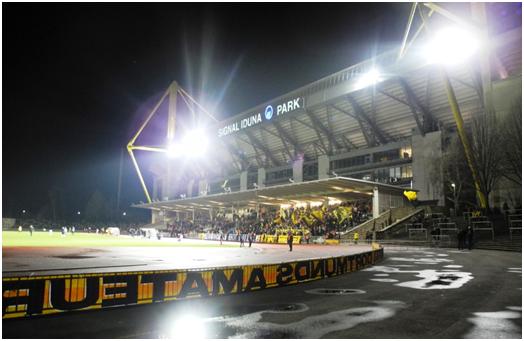
For a start, you have the historic ground. You see a number of similar examples around Germany, but few in such good conditions. The pitch is surrounded by a track, and all around the track is around 20 steps of concrete terracing, liberally sprinkled with crush barriers, and just a few dividers for the requirements of ground segregation, then you have the Westfahlenstandion (currently under the Signal Iduna name) looming high above the modest seating stand (which goes most of one long side).
Incidentally, the name Rote Erde means Red Earth, a reference to the old red mud pitches that used to be common in Germany, especially when the number of games and weather made grass an unsuitable surface. I have only seen one game on this surface, in the suburbs of Hamburg and the Rote Erde is actually Green Grass.
But what really makes this one special is a group of around 4-500 hundred home fans. Almost without break during the 90 minutes of play, this group were singing and shouting as if the match was a big game next door. The main difference being that those to the edge of the group (at least) were holding plastic beakers of beer in their hands, which limited their movement in some of the “jumping up and down”, or “clapping” moments. At the front of the group were a pair of drummers keeping the beat, and one “song leader” (there must be a German word for this, and it must have at least 20 letters) who always has his back to play as he organises the orchestra with a megaphone. I took some photos from behind and a distance, but when I tried to catch them from the path at the front of the stand, I was told “no photographs”.
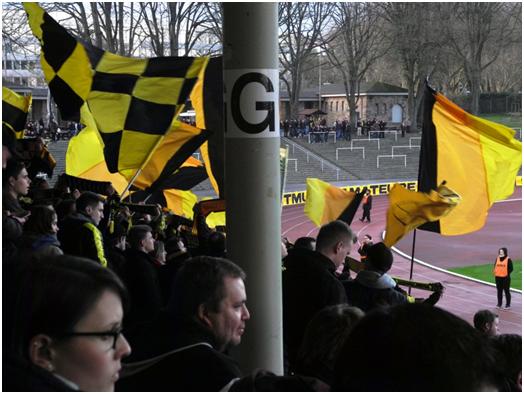
While there were a number of supporters waving (large) generic Dortmund flags, one near the front had what appeared to be a hand painted banner, on which the roman numerals II were heavily imposed over the Borussia badge.
Only in the last few minutes of the game did you actually get a sense that the singing group were actually aware of what was happening on the pitch. This was properly just as well, as what happened on the pitch was not particularly good. Stuttgart Kickers probably had the better of the game, with their wide play providing some hope, particularly Fabian Baumgartel – an overlapping full back. But their consistently low crosses always found the solid organisation of the Dortmund centre halves. It appears the home side felt it did not matter their full backs were not good, when the centres were so commanding. It may well have been Baumgartel who got himself fouled with 20 minutes to play just outside the box – it was Vincenzo Marchese (one of three Italians in the Kickers XI) who curled it into the top of the net to give the visitors the lead.
This at least livened up the non singing supports who had to this point settled for polite applause, but now could be heard berating the officials’ perceived mistakes and their own players’ actual mistakes. The other notable occurence was the appearance as Kickers substitute of Randy Edwini-Bonsu. This is not a name one forgets quickly, even if it was 4 years, and around 4000 miles distance since I last saw him. In 2010 he came off the bench to score a lake equaliser for Vancouver Whitecaps in the USSF Division Two, and then the next day I saw him start for their “Residency” (read youth/reserves) team at Tacoma in the PDL. Edwini-Bonsu managed the cross that had eluded the players earlier in the evening, getting the ball through to Marco Calamita on the far post. Calamita then managed to miss this gilt edged opportunity to take all the points. From the resultant goal kick, the ball was punted upfield (Dortmund do a lot of punting upfield), and the ball found its way safely to Daniel Wagner, the other goalkeeper. He somehow messed up not one, but two chances to hold onto the ball before Dortmund sub Thiele took the opportunity to stretch just enough to connect with the ball and put it into the net. Cue for more celebrations than normally seen for the winner at a cup final. Even the singers momentarily dropped their beat to acclaim the brilliance of the event.
There was a sign behind the goal Borussia Dortmund Amateurs gegen spieltagsuberschneidungen. This is something about overlapping matchdays – but what the campaign is about I do not know? Supporters in Germany have always been against changing kick off times away from Saturday afternoon (even though this is not used much by the 2.Bundesliga). I wondered if Dortmund’s second team were against any move to make them play at the same time as the first XI, (clearly not possible if both are at home the same day). Perhaps also this is an old poster – it is the only reference I saw to the team as Amateur. The team list called them Borussia Dortmund II, while the website and match ticket uses U23 as the designation. About half the team are listed in the First team squad list on soccerway, but most of those have not actually played a Bundesliga game.
Back to the Stammhaus where I had only a short wait before meeting the others, whose transport back from the local stadium had been made easy by a protest against a home team described as absolutely abject by our neutral viewers. This time it was Altbier all around, followed by two of our party, (no names, but not me), deciding they wanted to keep the mugs.
From what I understand, the police are now looking for this man, last seen on a regional train between Bochum and Koln.
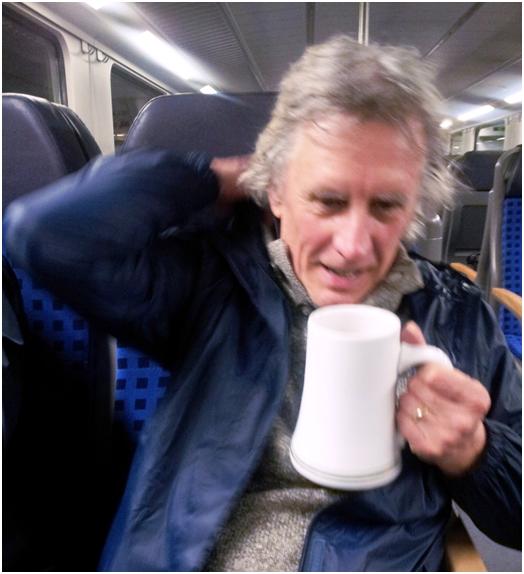
The next morning, the plan was to have a fry up and then take a drink in the old town before getting the tram out to the local venue to see 1. FC Koln. In the end, by the time we had all awoken and the breakfast had been dealt with, we decided to cut things short and head straight to the ground. The Rheinenergie Stadion (current name) was just plain Mungersdorfer when I last went and it has been completely rebuilt as a functional stadium. There is nothing at all wrong with this stadium, but I doubt if it ever troubled the architectural awards. There are a number of other sporting facilities around, I saw a sign pointing to the American Football ground, and there is a large grassed expanse between the tram stops and the stadium with a number of outlets each side of the main path. We soon queued up and obtained the first Kolsh of the day, (and the second). Inside the stadium one has to buy a stored fan card to buy more food and drinks, but Brian did this, and got enough added for more beer, which of course we drank by our seats in the stadium.
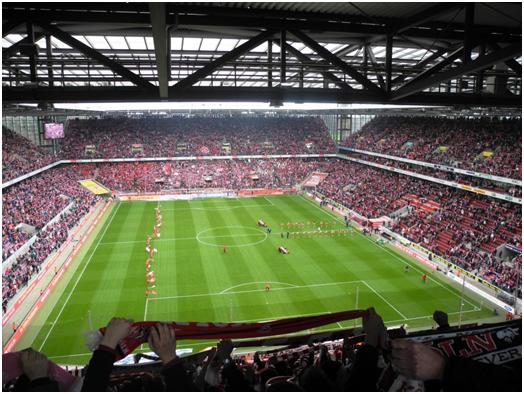
The matchday programme was in two parts, a large A4 magazine which covered two games, and a simple A5 sheet which unfolded to A3 and included the line ups. Both were free of charge. Our seats were at the top behind a goal. Brian had bought these in advance on-line with a face value of €23.50. The views from up here were very good, but the game was not. The visitors VfR Aalen had come to park the metaphoric bus, and despite being league leaders, Koln did not have the guile to break down formation that while listed as 4-3-2-1, actually reduced to 6-3-1 whenever the slightest pressure was applied.
At the end of the game, it was straight back to the hauptbahnhof for a train to Mönchengladbach. Two themes that were to be common to the trip were in evidence. Trams would appear by magic within seconds of us arriving at the stop, (or were already there and waiting), but as I had found out on previous trips, most trains run around 5-10 minutes late. The first train of this short trip was no exception, but as we had a 19 minute connection this did not make any difference when boarding a rare on-time train at Neuss.
At Neuss, we ran into another English groundhopper, pairing the same grounds as ourselves. This was none other than Stockport’s finest, Len Spirenburg who was making his first trip to Germany. Len was travelling without Ben, and looked rather bereft without his normal canine companion
On arriving in Mönchengladbach, we spurned the buses taking everyone directly to the ground and instead headed town wards. We found an uninspiring pedestrian street with a few vendors in a side street. We settled into an almost empty bar for a couple of glasses of Altbier, which did go down pretty well. We returned to the station and picked up the shuttle to the ground in good time. The ground is at Northpark and is around a 20 minute bus ride from the station. There is a business park as well as the football ground, and it badly needs a better transport link than the shuttle buses.
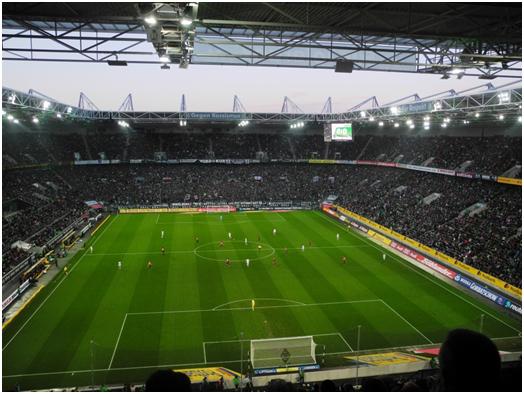
The ground is another functional venue with unadorned concrete outside. As with Koln, inside every site line is perfect. Despite the attendance being some 6000 more than the earlier game, the chanting does not quite seem as passionate, or as well choreographed as at Koln. We were again high up behind the goal, and a full pitch length from the standing section. One thing that probably made a difference was the number of corporate seats, filling most of one side. I still get the feeling that the Germans understand the dynamic of the crowd structure better than we do in Britain. Those in the corporate seats are there to be entertained, and the noise emanating from the singing sections at the ends of the ground are part of the entertainment.
In the first half of the game, Borussia tore into the Hertha defence, a direct style (both teams lined up 4-4-2) which paid dividends. The 3-0 lead at half time was no more than they deserved, but of course meant the game was over as a contest. Hertha had played part in the entertainment until they went behind and then lost confidence badly. The second period was very different. Hertha played a game of “what we have, we hold”, holding possession and playing the ball from side to side along the back four without ever making a threatening move. In short, playing for a 3-0 defeat. Mönchengladbach took this in their stride. If Hertha wanted to lose 3-0, then their wish could be granted and hence they did not work particularly hard to break down the now stubborn defence.
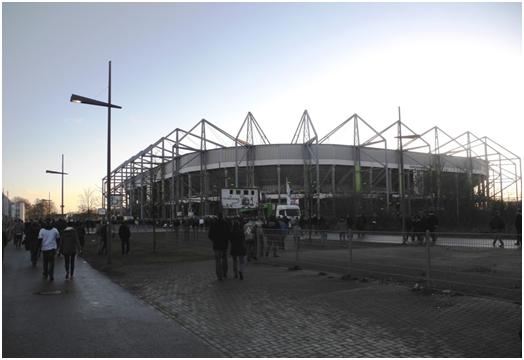
It was at the end of the game that we really saw the problem with 53,000 with limited transport options. I had seen on my previous trip that despite the close proximity to motorways, it takes a long time to drive away from the park. This does not appear to have been changed. If this is bad and slow, queuing for the shuttle buses back to the station was worse. It took us over an hour to get onto the bus, with the crowd pushing and shoving to get onto the buses. Stewarding was minimal, and the risk of injury in the crush clear for all to see. As Youngy said when we got back on the train – if the people of Mönchengladbach put themselves through this 17 times a season, there cannot be many alternative entertainments available in the town. We just made the hourly direct train to Koln, 90 minutes after the game finished, and returned to our rooms with a selection from a late night off-licence/grocer we passed just after exiting the station. (I was incorrect when I said on approaching the first one, that there was another closer to the hotel – there were at least two).

Sunday starts quietly, we have a train journey of over two and a half hours to Bielefeld, and do not start on the beer until we had arrived inside the stadium. I had not realised how much the ground had changed since my previous visit. It is yet another perfectly aligned modern stadium. It is sensibly sized, so the 11000 crowd does not get lost in space, but this means it can only hold 5000 more than the 22,512 which was the sell out crowd figure for every game in their first top level season, (I was there 16 years ago for that). It is going to be a while before this becomes an issue though, and this season the mission for Arminia is to avoid a return to the Third division, rather than plot a return to the top. It is a mission that they seem ill-equipped to succeed in. Energie Cottbus came to the ground as the bottom team in the division, but did not show us how they got to that position. Instead they deservedly won the game, the excellent Boubacar Sanogo giving them a first half lead. Despite Jan Fiesser’s second yellow card, just before the hour mark reducing the home side to ten men, Bielefeld clutched at the possibility of a point with a leveller ten minutes from time. However, a comic own goal put Cottbus back ahead. The goalkeeper made a save, which bounced off the back of the centre half (Salgar) and trickled slowly into the goal. Sanogo then tied things up with another goal in injury time.

Almost all of the away fans, who have survived a journey that will have commenced around 08.00 on a Sunday morning are penned into a small enclosure in one corner, although a few are climbing the perimeter fences – not so much to get a better view as to lead the cheerleading
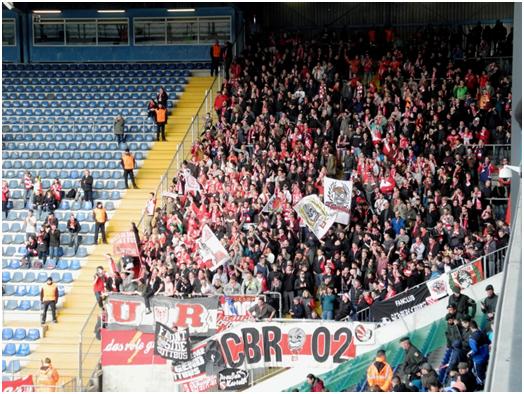
The matchday programme at Bielefeld is entitled halbvier, this is a reference to the traditional Saturday afternoon kick off time for Bundesliga games (3.30). It is wishful thinking, as in the second and third divisions, the 3.30 kick-off is never used these days, with most matches completed before the top division games of the day take place. Our 1.30 kick off at Bielefeld meant that we could travel back to Koln, and take a place in a sports bar in good time to catch the big event of the day, El Classico, Real Madrid v Barcelona. The sports bar is American themed, but with German beer. You cannot get better than that. The bar was standing room only for the game, so we had done well to turn up while tables were still available, get a good steak and more beer than should be mentioned. After all, apart from the lagers drunk at Arminia, it had been a dry day to this point.
Culture was saved until the last morning, when we finally visited the Dom, Cologne cathedral which dominates to walk between hotel and station.

I have been in before, but it is many years since my last visit, I have been in and out of the station many times since.
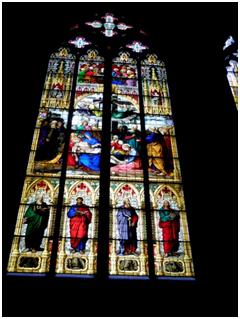
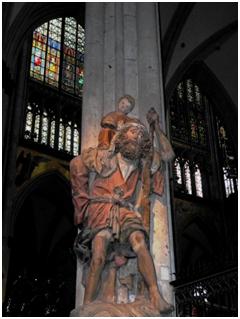
But enough of culture. James still has a point to prove, so it is off to Düsseldorf, where a brewpub near the river has had the hour of featuring on a BBC reality show, because some BBC presenter or other can trace his family back to the one that started this brewery, some centuries ago. James keeps referring to this as Ricky Stein’s place, but as he cannot trace his family back to the Steins that played for Luton and Barnet, it means little to me. Anyway, more beers (lovely Düsseldorfer Alt) are served and James proves the point. Someone on this trip can arrange a piss up in a brewery